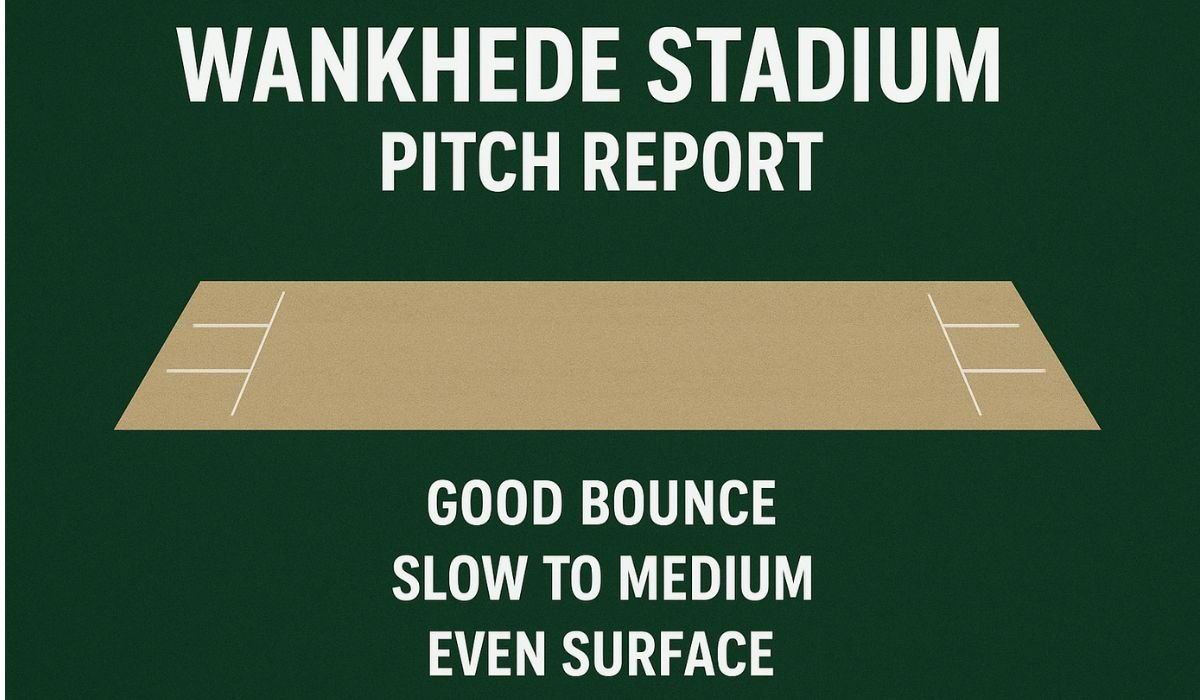Wankhede Stadium Pitch Report – The Wankhede Stadium in Mumbai is one of the historic venues in Indian cricket, especially in the Indian Premier League (IPL). The stadium offers a picturesque setting on the coast of the Arabian Sea. It is considered a high-scoring ground, especially in the T20s. The stadium’s pitch is typically made up of red soil, which generally provides good bounce and pace to the players.
This pitch initially benefits fast bowlers, and when it settles down during the match, it becomes best for batting. The boundary, which is a short square, is the highlight and a defining feature of the stadium. Thus, this pitch makes it easier for batsmen to score runs quickly and keep the opponent team under pressure.
The pitch is considered a flat track, favouring batsmen. However, it also has some space for assistance for the bowlers. Moreover, the sea breeze supports pacers in creating swing, especially with the new ball. Talking about the spinners, they can come into play when the pitch starts showing signs of wear and tear. Another crucial factor at the Wankhede Stadium is the dew factor.
This factor often affects the night match, making the ball wet and difficult for bowlers (especially spinners) to grip. Thus, the team that bats second has more advantage at this stadium. Also, this is the main reason why the team that wins the toss at this stadium chooses to bowl first. Having said that, let us take a look at the Wankhede Stadium pitch report in this article. Scroll down and read further.
How does the Wankhede Stadium Pitch behave?
The Wankhede Stadium pitch is known for its distinct characteristics, making it a unique and high-scoring venue. The pitch is made up of the red soil, which plays a crucial role in how it behaves. The bounce and pace that the pitch provides benefits fast bowlers, helping them get some zip off the surface. Moreover, the bounce also makes it ideal for batsmen to score good runs quickly and hit through the line of the ball. Another pleasing factor about this venue is its short square boundaries. This factor also presents an ideal condition for the batters, making it a ‘batter’s paradise’. This makes it a high-scoring pitch.
Although the pitch is generally considered a flat track, it also offers some assistance to the bowlers. The sea breeze from the Arabian Sea helps pacers generate swing with the new ball, and as the game continues, the pitch also brings spinners into play. Another significant feature of the Wankhede Stadium Pitch is the dew factor, often reflected in night matches. Dew’s presence makes the ball wet and difficult for bowlers to bring their best game. Especially for spinners, dew makes it difficult for them to grip. This, in turn, gives advantage to the team that bats second. This is why the toss-winning captain at Wankhede chooses to bowl first.
Wankhede Stadium Pitch Report Ground Overview
Located in the financial capital of India, Mumbai, Wankhede Stadium is an iconic stadium that is known for its atmosphere. What makes it more special? It is located near Marine Drive, offering a unique coastal touch.
- Capacity – The stadium has a capacity of 30,000 spectators.
- Ends – The two bowling ends are named as the Garware Pavilion End and the Tata End.
- Stands – Like other big stadiums, Wankhede also has various stands, including the Sunil Gavaskar Stand, the Sachin Tendulkar Stand and the Rohit Sharma Stand.
- Architecture – It has a cantilevered fabric roof, providing a panoramic view of the playing area for the audience.
Pitch & Boundary Dimensions
- Pitch Type – The pitch at Wankhede Stadium is made up of the red soil, which is known for its good bounce and pace.
- Boundary Length – The ground has short boundaries, i.e., about 64 to 68 meters. Also, the straight boundaries are 68 to 72 meters.
Historical Significance
The Mumbai Cricket Association (MCA) owns and operates the stadium. It also serves as the home ground for both the Mumbai Cricket team and the Mumbai Indians in the IPL. Not to forget, it has hosted several memorable matches, including the 2011 ICC Cricket World Cup Final, where Mahendra Singh Dhoni finished off in style to beat Sri Lanka, and made India the first country to win the World Cup on home soil. Also, Sachin Tendulkar played his last international match at this stadium.
Wankhede Stadium Pitch Report in Tests
While the Wankhede Stadium pitch is batting-friendly, it offers a dynamic nature in test cricket, which evolves over the five days
Early Days (Days 1 and 2)
As the pitch is made up of red soil, it offers good bounce, and the ball comes nicely onto the bat. Thus, initial test days are great for batting, and you can also expect some big first-innings totals. Further, when the new ball combines with the sea breeze, fast bowlers can get some assistance in the initial days. You can expect some good movement off the seam.
Later Days (Days 3, 4, and 5)
As the match continues, the surface, which is made up of red soil, develops cracks, which means that it’s the turn of spinners to get into the game. Further, by the fourth and fifth days, the pitch gets an unpredictable bounce, making batting very challenging and tough for batters.
Wankhede Stadium Pitch Report in ODI
The red soil pitch in the Wankhede Stadium, especially in ODIs, is a paradise for batsmen. However, the behaviour of the pitch also depends on various other factors, including the time of day.
Batting Friendly
The pitch offers a constant bounce, which helps batters to play their shots easily. The venue is perfect for aggressive batting as the ball comes onto the bat nicely. Also, the short boundaries help batsmen to score high totals. Talking about the average first innings score in ODIs at Wankhede, it’s 255.
Pace Vs Spin
With the new ball, pace bowlers get some initial assistance, thanks to the sea breeze that generates swing and seam movement. Talking about spinners, they have a tough time on this pitch, especially during the first innings. During that time, the surface doesn’t offer much help to the spinners.
The Impact of Dew
Due to the proximity of the Arabian Sea, the stadium experiences heavy dew during the night matches. It makes the ball wet and difficult for bowlers to grip. Thus, chasing targets at Wankhede is easier than batting first. This is why toss-winning captains at Wankhede choose to field first.
Wankhede Stadium Pitch Report in T20I
The red soil pitch at the Wankhede Stadium, particularly for T20s, is a batsman’s paradise to hit high scores with ease. But the pitch behavior also varies based on numerous other factors, such as the time of day.
The pitch provides a consistent bounce, which makes it easy for batters to play shots. The ground is ideal for attacking batting since the ball comes onto the bat well. Furthermore, the short boundary facilitates batsmen to post big scores.
With the new ball, pace bowlers do get some initial help, courtesy of the sea breeze causing swing and movement. Speaking about spinners, they find it difficult on this wicket, particularly in the first innings.
Toss and Match Strategy Summary
Due to the variation in behaviour of the Wankhede Stadium, the toss and match strategy hold great importance. Winning the toss at the Wankhede Stadium is considered an advantage because the toss-winning captain can decide to bowl first and chase the total easily.
Talking about bowling first, with the new ball, fast pacers can get some good early wickets, making it difficult for the opponent team to set big targets. On the other hand, the team batting first at the Wankhede Stadium needs to score a big total to put pressure on the opponent team, knowing the conditions will become easier for batting later on.
For the T20Is, 200+ score is good, and for the ODIs, a score of 300+ is good enough. Batsmen need to be aggressive from the start and shoot as many boundaries as possible, especially in the powerplay.
Historical Games and Significant Individual Performances
The Wankhede Stadium has hosted some of the most memorable matches of Indian cricket, including some extraordinary performances from the players. Take a look at some of them below.
- 2011 Cricket World Cup Final – The most memorable match in the history of Wankhede Stadium is definitely the final of the 2011 ICC Cricket World Cup, where Mahendra Singh Dhoni finished off in style to beat the rivals Sri Lanka by 6 wickets after the Lankans set a challenging total of 274. This made India the first team to secure a World Cup on home soil.
- Sachin Tendulkar’s Last Test – Back in November 2013, Wankhede Stadium hosted Sachin Tendulkar for the last international match of his career. It was his 200th and last test match, against the West Indies, giving an emotional farewell to the ‘Master Blaster’. That day, he played a memorable knock of 74 runs.
Conclusion
In conclusion, we can say that Wankhede Stadium stands as a historical cricket ground, holding several records and milestones. The red soil pitch is a batting paradise, and short boundaries contribute to high-scoring thrillers. The most crucial factor of the stadium is the dew factor, which makes it difficult for spinners to get a grip of the ball, giving advantage to the chasing them. Hence, the mantra is simple at Wankhede: win the toss and bowl first. Lastly, with a history of such records and performances, the stadium is considered to host many more matches in the future, and spectators may also witness some notable achievements of the players. Stay tuned for further updates.
Learn More:


